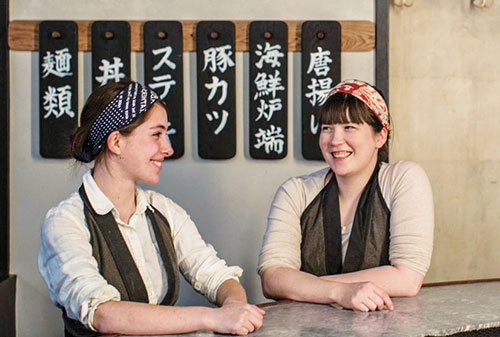Kitchen creative: art history major finds niche as chef

In the heart of Brooklyn, there’s a classic American diner known as Walter’s. But it has a secret. Behind an unmarked back door, you’ll find another restaurant: Karasu.
Elena Yamamoto ’09 works as co-chef of both.
“[Karasu] often gets labeled as a ‘speakeasy’ since we’re located in the back of another restaurant,” she said. “While we enjoy watching new customers discover a bustling restaurant behind an unmarked door, we advertise and welcome everyone. We even write ‘Walter’s and Karasu’ on the chalkboard out front.”
Originally from New Jersey, Yamamoto didn’t set out to be a chef. At Messiah, she majored in art history and studio art. She says her art history classes gave her the perspective to see her place in the world, while her visual art classes helped her develop and share ideas.
“The confidence that I gained in my own voice and perspective—having to articulate it, defend it, make it physical—laid the foundation for who I am today in the world and in the kitchen,” she said.
After graduation, she worked at the Arthur M. Sackler Gallery and the Freer Gallery of Art in Washington, D.C., waiting tables at night. However, she realized that a career in art wasn’t a good fit. So, she traveled to Japan, where she “studied cooking by doing” for three years. When she returned to the U.S., she had a renewed passion for the restaurant environment—this time, prepping and cooking in New York.
“I fell in love with the camaraderie and the community that the food industry champions,” she said. “I was able to learn from so many different co-workers and chefs, learning different types of food and approaches to cooking at various restaurants in New York and Tokyo.”
Karasu is based on a traditional izakaya—a Japanese pub. Yamamoto and her co-chef Yael Peet serve a mix of traditional dishes along with some riffs on standards.
Yamamoto says she views the culinary arts as a form of hospitality. This distinction, as well as her Japanese-American family heritage, is why she chose to work in Japanese cuisine: the focal point being omotenashi, serving other people.
Hospitality is based on the relationship between house and customer,” she said. “I can’t think of a better way to get to know someone than to share a meal with them, and so creating that space, setting the tone, fulfilling cravings, helping people be present and enjoy themselves and each other’s company is a worthy pursuit.
She also likes the simplicity of the cuisine. “Traditionally, the most ideal examples of Japanese food are those dishes that bring out and highlight the natural flavors of the ingredients rather than techniques that are meant to dazzle and transform,” she said. “I’m attracted to that honesty.”
Although her art degree and her culinary career may seem contradictory, Yamamoto says that creativity assists her in the kitchen. Color theory and balance are two important elements of her plating.
“In traditional Japanese food, you eat with your eyes first,” she said. “A beautiful presentation prepares your mouth and body for the perfect, delicious bite of food.”
As she continues on her culinary journey, Yamamoto stays humble. “Seven years after starting out on this path I’m running two kitchens [Karasu and Walter’s],” she said, “and I’m finding that the more I learn, the more I realize that I’ve only scratched the surface.”
— Rachel Hungerford ’22